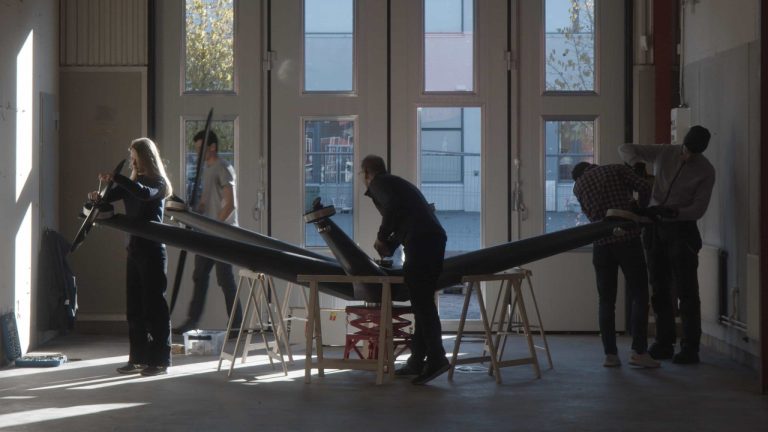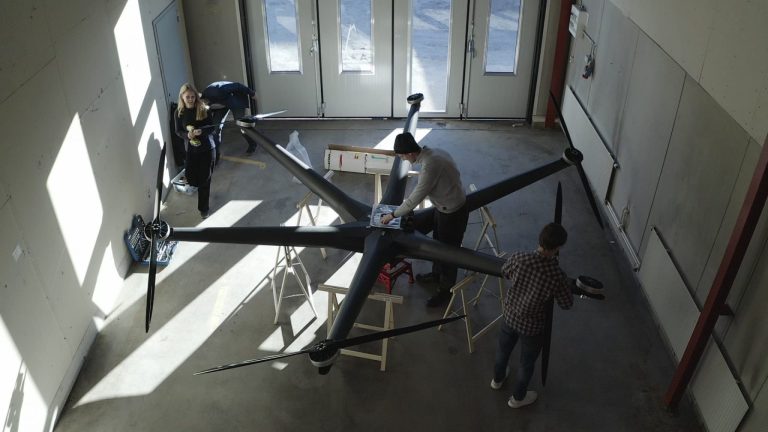Just as I claimed there is no giant steps insight in the development of forest machinery, something turned up.
AirForestry is a new Swedish start-up company whose idea is to cut trees with a drone. The drone has a diameter of 6,2 meters (19 ft), and its harvester head delimbs the tree from the top down to the root, where it cuts and lifts the tree out of the forest.
This is a summary of an article signed by Fredrik Reuter at iSkogen.se
Thinning with a drone
Thinning forest from the air is not entirely new. It´s done by helicopter and has been so for decades. But doing it with a drone is something unique. If it succeeds in going commercial, it will have an excellent potential to become the giant step I asked for in the last article here at NordicWoodJournal.com. Battery-powered = “fossil-free” cutting, all the way to the landing. It´s even politically correct.
Photo: AirForestry
Testing with the drone starts in 2022
AirForestry, which was started by, among others, Olle Gelin, former at Skogforsk, has chosen to release the news about the “drone-harvester” quite late. The harvester head has already been tested, and a full-scale drone prototype is being built right now. Testing of the complete machine in the forest will start in 2022.
Apart from Olle Gelin the company is run by Markus Romer, Mauritz Andersson and Caroline Walerud. When we reached Olle on the phone, he explained that the team possesses sound knowledge in forestry, drones, and digital technology with autonomy.
Photo: AirForestry
How is thinning by drone done?
The idea of the concept is that you transport the folded drone(-s), batteries, and harvester head(-s) to the thinning site on a standard car trailer. The weight of one drone will only be 80 kg (176 lb.), so it can easily be transported with a regular car and with a typical driver’s license.
At the landing, the drone(-s) is started up and sent to the thinning site. Initially, the system will need ground staff to mark the trees that should be cut. The idea, however, is that also this should be done autonomously in the future.
When a tree is chosen, the harvester head is attached to the top and delimbs the tree downward as the drone hovers above. When the harvester head reaches the root, it cuts the tree, and the drone lifts the whole tree straight up and takes it to the landing.
At the landing, the tree is cut to lengths by the harvester head and put in piles. CTL (Cut-To-Length) is the conventional method in Sweden (and other places) today. But AirForestry sees the possibility of using complete tree handling here in the future, especially for the pulp industry.
When the tree has been processed, the drone heads for the forest again to get the next tree. If batteries must be replaced, that is also being done at the landing.
Can drones improve thinning?
Already today, drones could be equipped with technology for recognition, coordination, and cameras. So, it should be able to do an adapted thinning for each type of stand. Add to that that you don´t need any strip roads, which means a minimum of stem damages on the left trees, and that all slash is left in the forest, and you will have the “perfect thinning”.
Theoretically, the drone can carry data for each site to take out precisely the correct number of stems to achieve the optimal growth in the stand after the thinning.
Thinning can occur at night, in the rain, snow, and up to a wind speed of 10 meters per second (22 mi/h).
The production rate compared to conventional methods
The first AirForestry prototype is being built right now. Therefore it´s difficult to say how many cubic meters per hour the drone harvester will produce. The analyzes that have been done show that the production rate will be at least as good as with a conventional system with harvester and forwarder. This is because the drone can always take the closest route, the bird path, to the landing.
Photo: AirForestry
There are also problematic trees, like multi-top hardwood trees, that could slow the production down in thinning. But also here, AirForestry has a solution as the harvester head can cut in different angles. For example, you could say that the drone can work as an arborist, felling tricky trees bit by bit.
According to Olle Gelin, the system will be adapted for the first commercial thinning with an average stem size of 0,06 cubic meters under the bark. The harvester can, however, handle stems of twice that size.
Side effects with a thinning drone
Apart from that, the outtake could be made optimal, and that there will be close to no ground or stem damages in the stand. The presence of a drone means that the forest stand could be surveyed appropriately simultaneously with the thinning operation. During the procedure, you can scan the stand before, during, and after the thinning has been done. This will give the forest owner an excellent picture of the forest stand.
As the drone is battery powered, meaning you can call the operation “fossil-free”, the system will gain many benefits in today’s climate-focused World. One might think that some big forest companies should be interested in investing in such a technology. It should be like a wet dream to claim that your felling operations are fossil-free! But no, no forest industry is involved in this project. Maybe it´s because the drone sticks to the recommended outtake, the outtake that is optimized for future growth? (And not to take out as much as possible today)
Anyway, this is exciting. We will follow this even if a commercial drone harvester probably is far away. It´s lovely to see that someone can think so far outside the box and don’t care about what the machines have looked like since the ’70s.
This could very well be the next giant step that I asked for.
Read more about the project on AirForestry’s home page.














